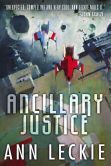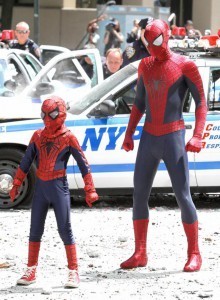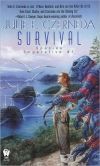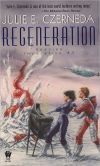Jim C. Hines's Blog, page 106
May 20, 2014
Guest Post at Special Needs in Strange Worlds
I have a guest post at Sarah Chorn’s Special Needs in Strange Worlds feature over at SF Signal today: Writing with Depression:
I get anxious every time one of my books comes out. Will this one sell as well as the last? Will people like it? Will Spielberg finally call me up and offer me an obscene amount of money to turn my books into blockbusters? Will this be the book that tanks and destroys my career, forcing me to live on the streets and hunt rats for food?
From what I’ve seen, that anxiety is pretty typical for most novelists. But I’m particularly nervous about my next book, Unbound. This is the third book in my current series, and will probably be out in very early 2015, give or take a few months. I’ve put my protagonist Isaac through an awful lot in the first two books. As a result of those events, when we see Isaac again in Unbound, he’s struggling with clinical depression.
Thanks to Sarah and SF Signal for running these essays!
May 19, 2014
Romantic Times and the Cool Kids Table
Yesterday, I began seeing links to Hugh Howey’s piece Being Forced to Sit in the Backlist, in which Howey talks about the Romantic Times Bookfair, in which:
“…the planners of the RT Booklovers Convention decided to place self-published authors in a dinky room off to the side while the traditionally published authors sat at tables in the grand ballroom.”
Howey goes on to propose that:
“Twenty years from now, when a new generation of more tolerant and inclusive artists finds themselves in the position to organize events like this, let’s not be dicks like our forefathers … There’s room enough for everyone. And the days are numbered for those who don’t agree.”
Reactions have ranged from outrage and disgust that once again self-published authors were being treated as amateurs, wannabes, and “aspiring authors,” to anger at indie authors for trying to liken their plight to the civil rights movement with Howey’s choice of title and comments along the lines of, “It’s like shades of Jim Crow when blacks had to sit in the back of the bus…”1
Howey wasn’t actually at the RT Bookfair, so I tried find some first-hand information, because I very much agree that there’s room for everyone, and if indie authors were basically being hidden away in some maintenance closet, then that’s definitely uncool. Here are several accounts and discussions I’ve found:
Thoughts on Indie Author Separation at the RT Convention Signing in New Orleans, by Elizabeth Hunter.
RT’s Giant Bookfair, by Courtney Milan.
An Absolute Write thread about Howey’s article, including comments by authors who attended RT.
In addition, the RT convention FAQs includes this bit:
“In the Traditional section of the Book Fair, you can only have up to three titles available. For the E-Book section, you can have swag for all of your available titles, as long as it fits within your space. For the Indie books on consignment section, you can only have up to three titles available.”
Both Courtney Milan and the RT FAQs mention the word consignment. Basically, consignment means you bring your own books to the event, and the event (generally) takes a percentage of sales. I’ve sold books on consignment before when a convention dealer didn’t have my stuff in stock, for example. Most of the time though, dealers are able to order and sell my books, because my publisher’s titles are returnable. In other words, if the books don’t sell, the dealer can send them back for a refund.
As I understand it, most self-published print-on-demand titles are non-returnable, as are some books by smaller publishers. And therein lies the problem, because dealers are much less willing to stock and sell non-returnable books.
It looks like there were almost 700 authors scheduled to be a part of the Book Fair. That’s a potential logistical nightmare waiting to happen. Imagine 700 authors all sitting there with stacks of their books, while approximately 3.6 bajillion readers maneuver through the aisles. For some of those books, the money goes to the dealer. For books on consignment, the money needs to go to the author. I’ve seen how confused readers can get with just a dozen authors when some are selling on consignment while others are selling through a dealer.
It seems to me that separating authors with returnable books from those with nonreturnable/consignment titles was an efficient solution to the problem.
That said, it sounds like there were real communication problems, from things like authors of nonreturnable books getting less space than promised to a volunteer mistakenly referring to the “aspiring authors” room to difficulties for readers who wanted to find a particular author and didn’t know which room to go to.
Like Howey, I wasn’t there, so I can only go by what I read. (Though it sounds like the overall convention was a blast, and I’d love to attend one of these days.) However, I’ve seen a number of people talking about this as a giant slam on self-publishing, and some over-the-top rhetoric about “intolerant dicks” treating indie authors like crap. As someone who has very little patience for the whole Us vs. Them worldview, I thought it was worth tossing my two cents out there to challenge that interpretation of events.
As with anything you read on the internet, I’d strongly suggest doing a bit of fact-checking and coming to your own conclusions.
—
Yeah, don’t do that. Just don’t. ↩
May 16, 2014
Cool Stuff Friday
I meant what I said, and I said what I meant. It’s Friday again — you can tell by the scent! Or something. I was a little tired when I wrote that. Anyway, enjoy the weekend, all!
Snuggling doggies.
Happiness is a Warm Slayer. Buffy cartoons in the style of Peanuts.
Carl Jara’s professional sand sculptures. Wow…
Alien, in LEGO. Scenes recreated in tribute to H. R. Giger.
May 15, 2014
SFF in Conversation at The Book Smugglers
The Book Smugglers have been running a series called SFF in Conversation. Today they’re hosting my piece Visibility Matters, which talks about Invisible and is loosely based on the keynote speech I gave at the Pikes Peak Writers Conference.
Go forth and check it out!
May 14, 2014
Impure Thought Police
A number of folks have been sharing the story about Clare, a seventeen-year-old girl who was kicked out of her prom. Reading Clare’s account, it sounds to me like there were two factors:
Mrs. D, one of the prom organizers, was on a power trip. She disapproved of Clare’s dress, and when Clare pointed out that it didn’t violate the dress code, Mrs. D couldn’t let it go. I remember dealing with teachers like that. I remember watching my brother go through it. My daughter recently had similar trouble with a woman at her school. A student points out that an adult is mistaken about something. The adult takes it as a challenge to their power and authority, and gets it into their head that they’re gonna show this punk kid who’s boss. I don’t know for certain that this is what happened to Clare, but that aspect of her story is both familiar and highly obnoxious.
A little later, Mrs. D pulled Clare aside to say, “some of the dads who were chaperoning had complained that my dancing was too provocative, and that I was going to cause the young men at the prom to think impure thoughts.” Clare said she had hardly been dancing at all, much less seductively. Mrs. D reiterated that the dress was too short, and told Clare she would have to leave.
There’s an update here, which asks people not to harass the prom coordinator, and notes that the moderators for the prom’s Facebook page were deleting comments and eventually deleted the whole page. Neither Mrs. D nor the administration have made any sort of statement about the incident.
So here’s the thing. I’ve got 40 years of experience as a guy. For the record, we men aren’t a bunch of delicate flowers who swoon at the mere sight of a girl’s legs. A young woman dancing doesn’t scar us for life.
The dads were worried about the young men at the prom thinking impure thoughts? Do they remember what it’s like to be a teenage boy? At that age, a stiff breeze is enough to make you think “impure” thoughts. It’s like Pavlovian condition gone mad. School bell rings? Boner! Sit down in the cafeteria? Boner! Adjust your seat belt? Boner! Trying to maintain my dignity as a teenage boy was like a neverending game of whack-a-mole…
Or is it that we don’t trust the boys to control themselves? That we think men are monsters, transformed by the mere sight of a girl’s thigh into slobbering, sex-crazed monsters, helpless to resist the Curse of the Visible Girlflesh.
Clare notes that she and her friends were grossed out by some of the Dads who were ogling them from the balcony. Which would be creepy as hell if we held men in any way responsible for their own actions, but of course we can’t blame them. Because apparently seventeen-year-old girl legs are made of man-kryptonite.
There’s nothing new in the attitudes here. We blame and punish the women, because it frees men from responsibility. But as a man, I find it insulting, tiresome, and damaging as hell.
May 13, 2014
Ancillary Justice, by Ann Leckie
 Ann Leckie‘s debut SF novel Ancillary Justice [Amazon | B&N | Mysterious Galaxy] has gotten a lot of buzz since its release. The book won the Clarke Award, the BFSA Award, made the honor list for the Tiptree Award, and is a Hugo Award finalist for Best Novel. I’m pretty sure it was also a Nebula finalist, tied for an Oscar, and won this year’s Super Bowl.
Ann Leckie‘s debut SF novel Ancillary Justice [Amazon | B&N | Mysterious Galaxy] has gotten a lot of buzz since its release. The book won the Clarke Award, the BFSA Award, made the honor list for the Tiptree Award, and is a Hugo Award finalist for Best Novel. I’m pretty sure it was also a Nebula finalist, tied for an Oscar, and won this year’s Super Bowl.
It’s an ambitious book, spanning centuries of future history. The protagonist Breq is all that remains of the Justice of Toren, an artificially intelligent ship with thousands of ancillaries — human bodies all controlled by the ship’s mind. Justice of Toren was essentially a single entity with thousands of bodies, and Breq was one of those ancillaries.
This isn’t a Star Trek-style Borg hive where individual personalities are subsumed into a collective; the host bodies are basically dead, without minds or personalities of their own. They’re “corpse soldiers.” Justice of Toren is one being who gets caught up in political crossfire and finds herself reduced to a fragment of what she was: a lone human body, limited and alone.
The first part of the book alternates between present and past, plunging the reader into the story and slowly providing the background. This is not a book you should try to skim. After I finished reading, I found myself wanting to immediately go back through the opening chapters again and pick up on everything I’d missed the first time.
I love the way Leckie plays with identity. Anaander Mianaai, the long-lived Lord of the Radch, is similar to Breq in that Mianaai has many human bodies, all linked. I won’t spoil things here, but I really liked the revelation of where the ongoing political conflict originated, and Mianaai’s role in it.
A lot of the conversations and reviews I’ve seen focus on Leckie’s treatment of gender in the book, both as a cultural construct — gender is treated differently depending on which culture Breq is immersed in at the time — and as a source of personal confusion. What is gender for a being with hundreds or thousands of different individual bodies? Breq often stumbles over gender identification and pronoun use.
It creates an interesting effect when a character Breq has referred to as “she” is then described as “he” for the next part of the book. I found myself rethinking their interactions, the dynamic between them, and more.
I don’t know that the book does anything truly new or revolutionary with gender, but it certainly does more than most mainstream SF these days, and I appreciate the way Leckie thought about it throughout the story.
Leckie also examines colonization, the destruction and assimilation of cultures, the drive for continued expansion and conquest, and more. It’s powerful and often painful. Aspects of that cold, calculating cruelty are what eventually launch Breq on her quest for vengeance.
I have mixed feelings about Breq’s mission. She’s out to kill as many of Anaander Mianaai as she can, but she also knows she probably won’t be able to take out more than one or two of Mianaai’s bodies before being caught and killed herself. Given that Mianaai has hundreds or thousands of bodies, I kept wondering what’s the point? Given the setup, that’s like avenging yourself on someone by cutting her fingernail.
It may be that Breq was simply lost and knew full well that this was a pointless mission, one that was little more than suicide. But if so, I wish that had been made a little bit more clear. (Or maybe I just missed it.) I do like that the ending went in a different direction, and how that set things up for the next book.
I should also mention the character of Seivarden Vendaai, who ends up accompanying Breq. Vendaai undergoes a powerful transformation as well, being a soldier a thousand years out of her own time. She’s a snob and a drug addict, completely burnt out and bitter. I very much appreciated seeing her growth — and at times, her backsliding — over the course of the story.
All in all, a thoughtful book with strong worldbuilding, and a particularly impressive debut. Ancillary Justice is book one of a trilogy. Book two, Ancillary Sword, comes out in October of this year. You can read an excerpt of the first book here.
I haven’t read all of this year’s Hugo-nominated novels yet, and I wouldn’t presume to pick a winner, but I think Leckie is a strong contender.
May 12, 2014
Amazing Spider-Man 2 (Spoilers Ahead)
We went out to see Amazing Spider-Man 2 over the weekend. I was nervous going in. Partly because the previews suggested we were getting Electro, Rhino, and Green Goblin. (Because overloading the story with villains has worked so well for other Spider-Man movies.) And the reviews I’ve seen have been iffy, at best.
It wasn’t a perfect film, but I enjoyed it. Anthony Garfield opened the movie with wise-cracking, web-slinging Spider-Man. Watching him take care of low-level bad guys was just fun. I like Garfield’s Spider-Man (anyone else now visualizing a fat orange cat in a spider-suit, going on about Mondays and lasagna?) a lot better than the last incarnation. All in all, I was pleasantly surprised.
And now, on to the spoilers…
#
THE GOOD
Emma Stone/Gwen Stacy: I love this character. I love that with the exception of the whole superpowers thing, she is Peter Parker’s equal — or better — in pretty much every way. She’s smarter. She’s strong-willed. She’s determined to live her own life, to the point where Peter Parker decides he’s going to accompany her to England.
Spider-Man says, “You must stay here where it’s safe while I fight Sparkles,” and she not only says, “Oh, hell no,” she cuts herself loose, steals a truck, and rams head-on into the bad guy, saving Spider-Man’s life in the process.
I’m particularly happy about the part where Gwen tells Peter it’s her choice. Not Peter’s, and not her father’s. She knows perfectly well how dangerous Spider-Man’s life is. So does Peter Parker. She makes her own choice. That choice gets her killed in the end, but that was her choice. She wasn’t kidnapped by the villain to use as bait; she drove out there to help kick the bad guy’s ass.
I’m very worried about where the movies are going to go without her, and without the chemistry she had with Anthony Garfield.
Smart-Ass Spider-Man: Oh, Spidey who clings to the side of the truck and quips with the bad guy, Spidey who scolds the plutonium cannisters (and catches one with his foot, which was a lovely touch), Spidey who can do angst and pain, but doesn’t spend the whole damn movie drowning in it (::cough:: DC ::cough::)… Never leave me, Smart-Ass Spider-Man!
Harry Osborne: I really liked Dane DeHaan’s portrayal of Harry/Green Goblin. His storyline didn’t get a lot of time or attention, and I know some people have been frustrated about that. But despite his crucial role in the end, this wasn’t his movie. This was his introduction, establishing the character and getting him ready for future movies. And in that respect, I think it worked. We see both sides of his character right away — the cold, emotionally abused son, and the guy who used to be Peter Parker’s best friend. “There he is!”
His few minutes as the Green Goblin were so much more effective than the last incarnation we saw on the big screen. The hair, the face, the cruelty … this is a supervillain.
 Spider-Man’s Interactions with People: This version of Spider-Man cares about people as individuals. He talks to the people he rescues. He saves Max Dillon, and stays long enough to help him gather his blueprints, and to make him feel important. At the end, when the little kid in the Spidey costume walks out in front of Rhino… Spider-Man’s exchange with that kid was flawless.
Spider-Man’s Interactions with People: This version of Spider-Man cares about people as individuals. He talks to the people he rescues. He saves Max Dillon, and stays long enough to help him gather his blueprints, and to make him feel important. At the end, when the little kid in the Spidey costume walks out in front of Rhino… Spider-Man’s exchange with that kid was flawless.
Hope is a strong (at times, too strong) theme throughout the movie, and it’s not just hope that some dude in spandex will save the day. It’s Spider-Man taking the time to remind everyone he meets that they matter.
THE BAD
Gwen Stacy’s Death: We knew it was coming. Even if you weren’t familiar with the comics, Gwen gets up in the beginning of the movie to give a speech called, “Hey Everybody, I’m Gonna Die By The End Of This Movie!” And while I think it was done well, I wish they’d let her go off to England. Instead, her death sets up Peter Parker’s angst and pain and guilt … and all of those emotions are valid and powerful, but it’s a story we’ve seen so many times before, and I’m very sad that we won’t have Emma Stone and Anthony Garfield together in future films.
Also, what the heck was up with that slow-motion webbing morphing into the shape of a hand and reaching? Yeah, don’t do that.
Dr. Kafka: This is the evil researcher dude with the ridiculous accent at Ravencroft Institute. He only had a few scenes, but he packed an entire movie’s worth of over-the-top WTF into them. (ETA: It gets better. In the comics, Dr. Kafka is a woman who is a friend of Spider-Man, and one of the good guys. But apparently someone thought a caricatured Nazi dude would work better for the movie.)
Max Dillon/Electro: I feel like this character should go more into “The Meh” category than “The Bad.” He was … they tried. They gave us an isolated, socially awkward character we could sympathize with, and added some signs of mental instability (the Spider-Man shrine, his fantasy about physically attacking a coworker who dissed Spidey, etc.) After his transformation into Electro, we see Spider-Man starting to get through to him, and then a Series of Unfortunate Events sends him over the edge into full-blown bad guy.
And I wasn’t feeling it. I thought the effects worked pretty well, and I liked his costume later on, but I never really cared about him as a character or villain. What did he want? To reclaim the power grid he designed, and for people to see him. But the power grid thing isn’t something that really grabs the audience, and the latter doesn’t really fit with the Power Grid Quest. I feel like his storyline needed at least one more rewrite, and it could have been so much stronger.
The Fate of Richard and Mary Parker: Well that was anticlimactic. We learn why the spider venom works for Peter and not for anyone else, but beyond that, I didn’t feel like the backstory on Peter’s parents added much of anything to the movie.
ETA - Stalking the Ex: Spider-Man following Gwen around every day after they broke up? Not romantic. Creepy. Can we please get rid of this trope already?
#
There’s a lot more I could talk about, and things I’m probably forgetting.
The on-again/off-again relationship drama was a little too much, I thought, but it also made sense, and certainly works as teenagers trying to sort out a very complicated relationship. Very glad Glen was the one to break it off at the restaurant.
Liked the more classic costume for Spider-Man.
“I hate that song!”
But enough of me blathering on. Have you seen it, and if so, what did you think?
May 9, 2014
Cool Stuff Friday
Cry “Havoc!”, and let slip the dogs of Friday!
20 Adorable Animals Caught Stealing.
Battle of Endor, in LEGO. Complete with exploding Scout Walker.
Cats on Dogs. That sounds like a Doctor Seuss book…
Robot kangaroo. I will be very sad if we don’t see these in the Terminator reboot!
May 8, 2014
Cover Reveal: Species Imperative, by Julie E. Czerneda
Today, I’m handing the blog over to author Julie E. Czerneda for the cover reveal of her omnibus, Species Imperative [Amazon | B&N | Mysterious Galaxy], which comes out September 2 of this year.
I enjoy Czerneda’s writing. I reviewed book one of this trilogy here and book two here (some spoilers in the reviews). I read and enjoyed the third book as well, but for some reason I either didn’t post a review or else I forgot to tag it so I’d be able to find it later.
Julie is also a wonderfully warm and welcoming person, and I’m happy to help spotlight her new project!
#
Presenting … Species Imperative!
I’m delighted to share with you the shiny new cover for DAW Books trade omnibus edition of Mac’s story. Thanks, Jim!
Those of you familiar with the original trilogy, Survival, Migration, and Regeneration, know the first of those titles was released in 2004. My first hardcover. My biggest, most ambitious work-to-date and a story near and dear to my biologist’s heart. Luis Royo did those covers, capturing pivotal moments in the story, and I loved them all. They were also covers where Luis and I, through his agent and interpreters (I don’t speak Spanish), worked together more than ever before. For each, I’d send 20-30 photos of the background setting, making sure to provide less familiar details such as rock structure and Arctic ice. In return, Luis provided those fantastic illustrations.



For the omnibus, however, it was time for something completely different. My output since 2009 having been a fantasy novel, albeit a Very Big One, I wanted it abundantly clear to readers new to Species Imperative that they’d be getting not just science fiction, but hard sf as well. Fans of this story called themselves biogeeks. Why? Because the scientific study of life runs rampant on every page and is crucial to the plot. Couldn’t be any other way. Mac studies salmon. It’s also what I intended from the start. This is speculation based as solidly as possible on known fact, that takes its leap into the unknown with eyes open. Here aren’t dragons — but you will find aliens wearing funny hats. For good reason, as you’ll see.
I’ve been a huge fan of the artwork of Kenn Brown and Cris Wren (also dear friends) for many years and had the privilege of working with them for the covers of ReVisions (DAW Books) and Summoned to Destiny (Fitzhenry & Whiteside). (Fun aside, I first met Kenn and Chris during my trip to Vancouver to launch Survival, for Mac’s Norcoast Research Facility is set on that glorious coastline.) Together they are Mondolithic Studios and please do spend time going through their gallery. Wow!
For that’s exactly what I did, quickly spotting an image Kenn had created for the cover of a past Discover magazine cover. Kenn worked closely with DAW to modify that starting point into the wonderful cover you see here. I couldn’t be happier.

As well as the cover, there’s a new introduction by Rick Wilber, a staunch supporter of Mac & Co since they came out and another friend. A new dedication, Biogeeks Unite!, and some kick’n new blurbs (thanks, Jim!) In sum, this is as much a celebration as it is a new edition, and I cannot wait to hold it in my hands. I’m sure I’ll sniffle.
Most of all, I hope you enjoy.
May 7, 2014
Prepping for Australia
In one month, my daughter and I are flying to Melbourne, Australia, where I’m joining Ambelin Kwaymullina, Sharon Mosely, and Danny Oz as guests of honor at Continuum.
To say I’m excited would be an understatement. The Continuum folks I’ve talked to so far have been great, the convention looks like a lot of fun, and on top of that, it’s my first time to Australia. I’ve been looking forward to this trip all year, and will be taking a little extra time after the convention to look around a bit.
Now, I consider myself a well-educated person, but I have to admit that my knowledge of Australia is a little limited. Here’s what I do know:
Everything is poisonous.
Drop bears.
So I throw myself on the mercy of the internet. Help me, hive mind.
What must I make sure to bring along?
What kind of electrical conversion doohickey do I need to make sure Australia’s power grid (which I’m assuming is poisonous) doesn’t kill my stuff?
What’s the best way to test for Iocaine Powder?
Do I have to check my shoes for koalas every morning?
What if I can’t find the “Australia” setting on my camera?
How nasty are the foreign transaction fees on the credit card likely to be?
Any tips for jet lag? (Right now, my plan is to try to stay up until bedtime on the first day to see if I can force my body into the new schedule. Either that, or just spend the whole time hallucinating.)
Will customs let me bring Hugh Jackman home as a gift for my wife?
Do wombats really poop in cubes? (Follow-up: Is cube-shaped poop poisonous?)
And what else should I know that I’m forgetting to ask about?



